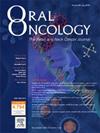调强放疗后甲状腺体积作为鼻咽癌放射诱导甲状腺功能减退的预测指标:一项回顾性研究
IF 4
2区 医学
Q1 DENTISTRY, ORAL SURGERY & MEDICINE
引用次数: 0
摘要
目的探讨调强放疗(IMRT)后甲状腺体积对鼻咽癌(NPC)患者放疗所致甲状腺功能减退/原发性甲状腺功能减退(HT)/ PHT发病率的预测作用。方法与材料回顾性分析2015年1月至2019年1月404例鼻咽癌患者。甲状腺体积根据磁共振成像计算。IMRT后3个月内甲状腺体积定义为Vt-after。采用最小绝对收缩和选择算子(LASSO)回归、随机森林分析和多变量Cox比例风险来确定PHT的最佳预测因子。然后,将这些预测因子运用递归划分分析(RPA)构建风险分层。结果Vt-after越小,HT/PHT发生风险越高(风险比:2.046,p <;0.001;HR: 3.214, p <;0.001;分别)。与IMRT前的甲状腺体积相比,IMRT后的甲状腺体积和1、2、3年的甲状腺体积在预测随后2年的PHT方面表现出更好的预测能力。45 Gy后甲状腺体积(VS45)和放疗后甲状腺体积(VS45)均为预测PHT的独立因素,纳入RPA风险分层,称为PRA-VS45。PRA-VS45是一个高度判别的工具,预测5年PHT的曲线下面积(AUC)为0.716。结论:本研究确定了IMRT后甲状腺体积是预测鼻咽癌患者放射相关PHT的有价值参数。PRA-VS45具有预测PHT的临床应用潜力。本文章由计算机程序翻译,如有差异,请以英文原文为准。
Thyroid volumes after intensity‐modulated radiotherapy as predictors of radiation‐induced hypothyroidism in nasopharyngeal carcinoma: A retrospective study
Purpose
This study aimed to investigate the ability of thyroid volumes after intensity-modulated radiotherapy (IMRT) to predict the incidence of radiation‐induced hypothyroidism/primary hypothyroidism (HT)/(PHT) in nasopharyngeal carcinoma (NPC) patients.
Methods and materials
404 NPC patients were retrospectively enrolled from January 2015 to January 2019. Thyroid volumes were calculated based on magnetic resonance imaging. Volume of thyroid after IMRT within 3 months was defined as Vt-after. Least absolute shrinkage and selection operator (LASSO) regression, random forest analysis, and multivariate Cox proportional hazards were performed to identify optimal predictors of PHT. Then, these predictors were employed to construct the risk stratification using the recursive partitioning analysis (RPA).
Results
A smaller Vt-after was significantly associated with a higher risk of HT/PHT (hazard ratio (HR): 2.046, p < 0.001; HR: 3.214, p < 0.001; respectively). Vt-after and thyroid volumes at 1, 2, and 3 years after IMRT demonstrated superior predictive ability compared to the thyroid volume before IMRT for predicting PHT within the subsequent 2-year period. The combination of Vt-after and thyroid volume spared from 45 Gy (VS45), both of which were independent factors for predicting PHT, was incorporated into the RPA risk stratification called PRA-VS45. The PRA-VS45 emerged as a highly discriminative tool, with an area under the curve (AUC) of 0.716 on predicting PHT at 5 years.
Conclusions
This study identified thyroid volumes after IMRT as valuable parameters to predict radiation‐related PHT in NPC patients. The PRA-VS45 has the potential to be clinical applications for predicting PHT.
求助全文
通过发布文献求助,成功后即可免费获取论文全文。
去求助
来源期刊

Oral oncology
医学-牙科与口腔外科
CiteScore
8.70
自引率
10.40%
发文量
505
审稿时长
20 days
期刊介绍:
Oral Oncology is an international interdisciplinary journal which publishes high quality original research, clinical trials and review articles, editorials, and commentaries relating to the etiopathogenesis, epidemiology, prevention, clinical features, diagnosis, treatment and management of patients with neoplasms in the head and neck.
Oral Oncology is of interest to head and neck surgeons, radiation and medical oncologists, maxillo-facial surgeons, oto-rhino-laryngologists, plastic surgeons, pathologists, scientists, oral medical specialists, special care dentists, dental care professionals, general dental practitioners, public health physicians, palliative care physicians, nurses, radiologists, radiographers, dieticians, occupational therapists, speech and language therapists, nutritionists, clinical and health psychologists and counselors, professionals in end of life care, as well as others interested in these fields.
 求助内容:
求助内容: 应助结果提醒方式:
应助结果提醒方式:


